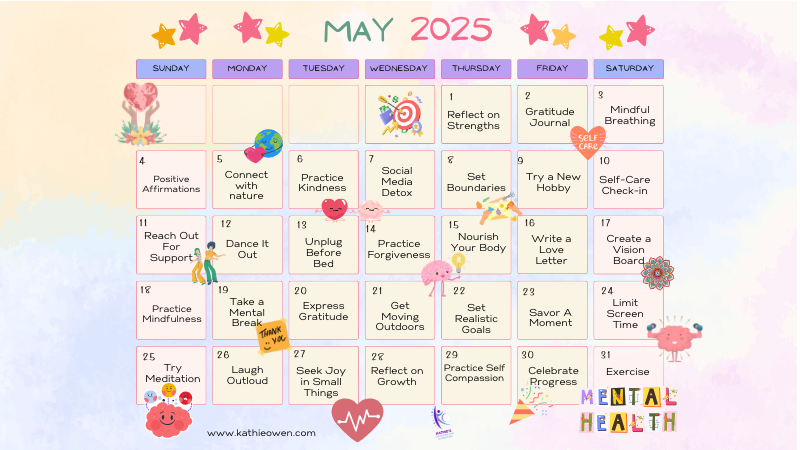Workplace Mental Health: A Leader's Guide 2025
Mental Health in the Workplace
Mental Health Isn’t a Destination—It’s a Leadership Decision
By Kathie Owen
As May—Mental Health Awareness Month—draws to a close, I want to share something that goes beyond green ribbons and workplace posters. Something raw, real, and deeply personal.
Mental health has been a long, winding journey for me. I was diagnosed with Complex PTSD in 2006, and more recently, I walked through the fiery terrain of chronic anxiety in 2024 and 2025.
Not the kind of anxiety you casually mention when you’re running late for a meeting. I’m talking about the kind that hijacks your nervous system and convinces you that everything—from sending an email to taking a nap—is dangerous.
And yet here I am, writing this, thriving in many ways, and leading wellness programs for organizations across the country. So, what changed?
The truth is, I realized something crucial: Mental health is the most important health we can care for—not just personally, but professionally. It’s not optional. It’s foundational.
And when organizations ignore it, they bleed talent, creativity, and humanity.
Let’s talk about why that matters.
C-PTSD and anxiety
The Journey Through Complex PTSD and Anxiety
When I received my Complex PTSD diagnosis in 2006, I finally had a name for what I had carried silently for years: the hyper-vigilance, the people-pleasing, the shutdowns, and the inability to feel safe in my own skin. It was validating, but also terrifying. Because then came the work.
I committed to healing, but like most of us who take mental health seriously, I quickly learned that healing isn’t linear. And it definitely isn’t convenient. I worked with therapists, read every book I could get my hands on, became a coach, and taught what I was learning. I even became a wellness director, hoping I could turn my pain into purpose.
But 2024 hit differently. After leaving a toxic work environment where I felt undervalued and gaslit, I found myself back in the thick of anxiety. My nervous system had been on high alert for months, and I didn't fully realize the toll it had taken on me until I could barely function without overwhelm.
I’d cry out of nowhere. I’d lose sleep over simple tasks. I’d feel guilty for resting. (Spoiler alert: rest is essential, not lazy.) I worked with a new anxiety coach and slowly began reclaiming my peace—this time, with deeper compassion and more tools than ever before.
And one of those tools? Workplace wellness.
Mental Health in the Workplace is a Must Have
Mental Health in the Workplace Isn’t Optional
If you’re in leadership, here’s a truth bomb for you: You set the tone. If your people are burned out, disengaged, and stressed, it’s not a badge of honor for your company’s hustle culture. It’s a red flag that your business is leaking energy at the seams.
And guess what? It’s fixable.
Companies that embrace mental health support—whether through corporate wellness programs, trained wellness directors, or simply normalizing the conversation—see a return that can’t be ignored.
We’re talking about:
Reduced absenteeism
Lower turnover
Increased productivity
Better team morale
Higher employee retention
In other words: Everybody wins.
But it has to start from the top. You can’t throw a yoga class at a burned-out team and call it “wellness.” You need buy-in from leadership. Real support. A shift in culture.
Work-Life Balance Is Not a Myth
Let’s debunk the idea that work-life balance is some fluffy, unattainable ideal reserved for freelancers and beach-working influencers.
Work-life balance is possible within the workplace—when we create systems, expectations, and support that honor the humanity of our employees.
As someone who now helps companies build successful and engaging corporate wellness programs, I’ve seen firsthand how things change when a company decides to care.
Not just say they care, but show it.
Through flexible schedules. Through mental health days. Through open-door policies and confidential check-ins. Through wellness challenges that are actually fun and engaging.
These aren't just perks. They’re lifelines.
And when employees feel seen and supported, they show up—not out of fear or obligation—but because they want to.
That’s what I help build.
And it starts with a single person.
We build healthy happy teams one heart at a time.
One Heart at a Time
You’ve probably heard me say it before:
“We build healthy, happy teams one heart at a time.”
And I mean that.
You are that one heart. So am I.
It only takes one leader, one voice, one ripple to start creating real change in the workplace. Whether you’re an HR director, a team lead, or a CEO (especially a CEO), you have the power to model what true wellness looks like. And true wellness? It’s not just fruit in the break room. It’s not a one-day seminar.
It’s a culture.
A mindset.
A commitment.
I’ve been through the trenches. And I’ve come out the other side—not perfectly healed, but deeply aware that the journey is ongoing. Mental health isn’t a destination. It’s a relationship. A commitment we renew every day.
And in the workplace, it’s no different.
Mental Health in the Workplace
A Personal Note to You
If you’re reading this and you're in the middle of your own mental health journey, please know:
You are not broken.
You are not alone.
You are allowed to rest.
And you are worthy of support.
Take care of your nervous system. Unplug. Get outside. Journal. Breathe. Cry if you need to. Ask for help. Talk to someone. Don’t let the world trick you into believing that your value lies in your productivity.
You matter. Your well-being matters. And the work you’re doing—on yourself and for others—is part of the ripple that will change everything.
Let’s build that ripple together.
One heart at a time.
10 Powerful Truths About Mental Health at Work
Mental health is just as important as physical health.
Untreated anxiety can mimic addiction in the brain and body. Read our article on Is Anxiety an Addiction?
Leadership must model healthy behavior for team wellness to stick.
Work-life balance is not a luxury—it’s a productivity strategy.
Wellness programs need buy-in to work—no one wants a “check-the-box” initiative.
Mental health is not a one-size-fits-all journey.
Burnout is preventable, but only when caught early and addressed honestly.
Talking about mental health at work breaks stigma and builds connection.
Small acts of compassion from leadership create lasting change.
Everyone benefits when employees feel safe, seen, and supported.
About Kathie Owen
Kathie Owen, Coach and Consultant
Kathie Owen is a corporate wellness consultant, speaker, and mindset coach with over two decades of experience helping people transform their mental and physical health.
A former fitness director and certified coach, Kathie now leads “Better You” challenges and corporate wellness programs that empower teams to thrive—emotionally, physically, and professionally.
Diagnosed with Complex PTSD in 2006, Kathie is a passionate advocate for mental health awareness and believes that the best teams are built one heart at a time.












High-level executives often hire multiple specialists—sleep coaches, therapists, trainers—but conflicting advice creates chaos. The solution? A performance quarterback who coordinates all experts into one aligned system. Real results: better sleep, lower stress, 40% performance boost. #ExecutivePerformance #LeadershipAlignment #HighPerformance #ExecutiveCoaching #POWERProtocol #PeakPerformance #ExecutiveWellness